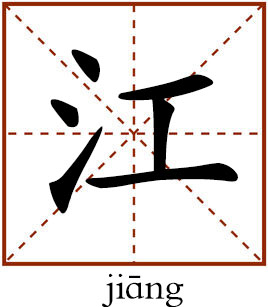River

This character refers to a river, particularly the Yangtze River.
春江水暖鸭先知
chūn jiāng shuǐ nuǎn yā xiān zhī
Chun refers to spring and jiang "a river." Shui refers to water and nuan "warm." Ya refers to a duck and xian zhi means "to know first."
This is a line from a lovely poem by the renowned Song poet Su Shi (1037–1101). A monk named Hui Chong (965–1017) drew a painting which depicted the evening scenery of a river in spring. Su liked his painting very much and wrote a poem for the painting: "Beyond the bamboos, two or three twigs of peach are in bloom./ The water in the spring river is warm: ducks know it before others./ Artemisia spread all over on ground; budding reeds are short./ It is precisely the time when the globefish is about to come up" (trans. Ye Yang). This poem highlights the time and season illustrated in the painting: the EARLY spring.
The sparse bamboo grove, and the detail that the peach blossoms not yet in full bloom indicate that the season is early. Then Su directed readers to pay attention to the ducks playing on the river, to further inspire their imagination in a humorous way: ducks know the spring is coming before the other animals because they notice that the water is warmer.
Artemisia herb is everywhere and reeds' buds just grow, which is also a sign of the early spring. The globefish didn't appear on the painting, but Su imagined that in the river there must be schools of globefish, because they only swim upstream in early spring when water gets warm. It is also a "delicious" line because globefish are viewed as a delicacy by the Chinese people. Another interpretation of the last line is that it is the right season to desire the incoming globefish. The poem is full of the beautiful breath of life. Su’s imagination enriches the spaces in the painting.
Only a few of Hui Chong's paintings exist today, but this painting is not included. Thanks to Su Shi, readers can still feel the charm of the painting today through reading this poem.
Edited by REN GUANHONG
